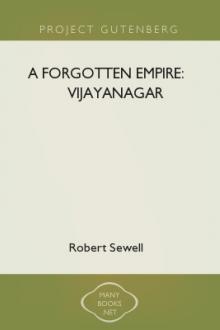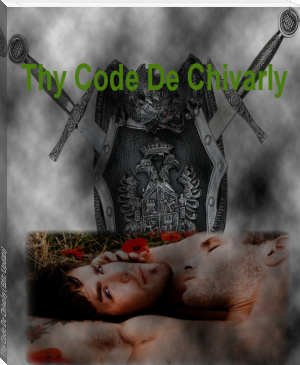A Forgotten Empire: Vijayanagar by Robert Sewell (short story to read TXT) 📕

- Author: Robert Sewell
- Performer: -
Book online «A Forgotten Empire: Vijayanagar by Robert Sewell (short story to read TXT) 📕». Author Robert Sewell
[17] — “Chronicle of the Pathan Kings of Delhi,” by Edward Thomas, p. 200.
[18] — Firishtah (Briggs, i. 413).
[19] — Elphinstone, “History of India,” ii. 62.
[20] — Lee’s translation, p. 144.
[21] — Sir H. Elliot’s “History of India,” iii. 215.
[22] — If we add together the number of years of the reigns of kings of Vijayanagar given by Nuniz prior to that of Krishna Deva Raya (“Crisnarao”), we find that the total is 180 (Senhor Lopes, Introduction, p. lxx.). The date of the beginning of the reign of Krishna Deva Raya is known to be 1509 — 10 A.D.; whence we obtain 1379 — 80 A.D. as the foundation of the empire in the person of “Dehorao” according to the chronicle. This is not quite accurate, but it helps to prove that “1230″ is a century too early.
[23] — Batuta was a native of Tangiers, his name being Sheik Abu’ Abdullah Muhammad. He arrived at the Indus on the 1 Muharram A.H. 734 (September 12, 1333 A.D.), and he seems to have resided in India till 1342.
[24] — The narrative is given in the French translation of Ibn Batuta’s travels, by Defremery and Sanguinetti (vol. iii. pp. 318 — 320). See also Sir Henry Elliot’s “History of India” (vol. iii. pp. 615
— 616).
[25] — Firishtah’s account is somewhat different, and he gives the date A.H. 739, or July 20, 1338, to July 9, 1339. But I consider the narrative of Ibn Batuta to be far the most reliable, since he wrote from personal experience, while Firishtah compiled his story two and a half centuries later.
[26] — This was Ghiyas-ud-din Bahadur Bura of Bengal, mentioned above.
[27] — This tale is told of the rise of almost every kingdom, principality, or large zamindari in Southern India, the usual variant being the discovery of a hidden treasure.
[28] — I think that there can be little doubt that this derivation, though often given, is erroneous, and that the name was “City of Victory,” not “City of Learning,” — VIJAYA, not VIDYA. VYDIAJUNA evidently represents VIDYARJUNA.
[29] — Buchanan (“Mysore,” &c., iii. 110), while on a visit to Beidur in Mysore in 1801, was shown by one Ramappa Varmika a Sanskrit book in his possession called the VIDYARAYANA SIKKA, which relates that the founders of Vijayanagar were Hukka and Bukka, guards of the treasury of Pratapa Rudra of Warangal. These young men came to the Guru, or spiritual teacher, Vidyaranya, who was head of the monastery of Sringeri, and the latter founded for them the city of Vijayanagar. This was in 1336, and Hukka was made first king. But this story entirely leaves out of account the most important point. How could two brothers, flying from a captured capital and a conquered kingdom, suddenly establish in a new country a great city and a sovereignty?
[30] — DECADA VI. l. v. c. 4.
[31] — “India in the Fifteenth Century,” Hakluyt edit., p. 29.
[32] — JOURNAL BOMBAY BR. R.A.S., xii. 338, 340.
[33] — There is an undated inscription, published in Dr. Hultzsch’s “South Indian Inscriptions” (vol. i. p. 167), on a rock not far from the summit of the lofty hill on which stands the virgin fortress of Gutti or Gooty in the Anantapur District, according to which that stronghold belonged to King Bukka. The place is seventy-eight miles east of Vijayanagar.
[34] — EPIG. IND., iii. 36.
[35] — An inscription of 1368 — 69 (Saka 1290, year Kilaka) mentions Madhavacharya Vidyaranya, apparently as still living. IND. ANT., iv. 206.
[36] — See my “Antiquities of Madras,” ii. 8, No. 58; Hultzsch’s EPIG. INDICA, iii. 21.
[37] — Briggs, i. 427.
[38] — This is in itself absurd, and carries with it its own refutation. It would be manifestly impossible for the city to be “built” in so short a time, and, moreover, it would have been sheer waste of time for the Prince to have employed himself in such a way. The sentence was probably introduced merely to account for that city having been built ABOUT this period.
[39] — Firishtah says on 1st Rabi-ul-awwal A.H. 759; A.H. 761 (A.D. 1359 — 60) according to the BURHAN-I-MAASIR. But the author of the latter work says that Ala-ud-din reigned thirteen years ten months and twenty-seven days, which would make the date of his death the 22nd of Rabi-ul-awwal A.H. 762, or January 31, A.D. 1361. He does not, therefore, appear to be very accurate. Firishtah gives in words the length of his reign as “eleven years two months and seven days.”
[40] — Certain inscriptions published by Mr. Rice state that the general who commanded Bukka’s armies about this time was Nadegonta Mallinatha, son of Nadegonta Sayyana. These bear date A.D. 1355 — 1356 and 1356 — 57.
[41] — Called “Nagdeo” in Scott’s translation (i. 19).
[42] — Briggs, ii. 307.
[43] — There is a confusion of dates here in Firishtah; but he definitely fixes the month and year when Muhammad set out, and we may accept it for the present. The BURHAN-I-MAASIR implies that the war against Vijayanagar took place prior to the campaign against Warangal. Firishtah places it certainly after the “Vellunputtun” affair.
[44] — Firishtah (Scott, i. 23).
[45] — Adoni as now called; Adhvani as properly spelt. This is a fine hill-fortress with extensive lines of walls, a few miles south of the River Tungabhadra and on the line of railway between Madras and Bombay.
[46] — We must never forget that the narrative of Firishtah is necessarily tinged with bias in favour of the Musalmans, and that it was not compiled till the end of the sixteenth or beginning of the seventeenth century A.D. The “infidels” are, of course, the Hindus, the “faithful” the followers of Muhammad the Prophet.
[47] — The country in question is a plain composed of a deep alluvial deposit, generally overlying gravel, and known as “black cotton soil.” After heavy rain it is practically impassable for traffic for some days.
[48] — The expression of Firishtah last quoted is deserving of note, as it implies that, according to tradition in his time, the Raya of Vijayanagar had by the year 1366 A.D. become a great and important sovereign.
[49] — Briggs (ii. 312, n.) considers it unlikely that the armies could have possessed artillery at so early a date.
[50] — Scott’s edit., i. 27.
[51] — Briggs gives the name as Bhoj-Mul. He MAY be the Mallayya or Mallinatha mentioned above (p. 31, note).
[52] — Sacred animals to the Hindus.
[53] — About forty-two miles.
[54] — The Tiger-Hunter.
[55] — 19th Zilkada A.H. 776 (Firishtah). The BURHAN-I MAASIR says in A.H. 775.
[56] — The BURHAN-I MAASIR calls the Raya “Kapazah.” Major King says that even the vowel marks are given, and there can be no doubt about the name. I venture to hazard a conjecture that if the word had been written “Pakazah,” transposing the first two consonants — a mistake occasionally made by writers dealing with, to them, outlandish names — the sound of the word would suggest Bukka Shah. There is no name that I have met with amongst those borne by the kings of Vijayanagar in the remotest degree resembling “Kapazah.”
[57] — Firishtah relates a story which is hardly sufficient to account for Bukka’s faint-heartedness. He says that Mujahid went one day while on the march after a man-eating tiger of great ferocity, and shot it with a single arrow through the heart. “The idolaters, upon hearing of this exploit, were struck with dread.” At the present day, at least, there are no tigers in the country between Adoni and Vijayanagar, though panthers are plentiful enough.
[58] — Firishtah, ii. 332 n.
[59] — A French map of A.D. 1652, published by Mr. Danvers (“Portuguese in India,” end of vol. i), shows at this spot “C. de Rames,” but the modern Ordnance Map has no place of that name in the vicinity.
[60] — It should be noted that Firishtah has previously described Mujahid, though he was then only about twenty years old, an a remarkably powerful man. He states that at the age of fourteen he had broken the neck of an opponent in a wrestling match.
[61] — Probably Marappa or Muddappa.
[62] — It will be seen hereafter that the kingdom was divided into provinces, held by nobles an condition of maintaining large armies ready for service at any moment.
[63] — Some authorities say that Daud was Mujahid’s cousin.
[64] — “Dhunna Sodra” is, I think, a lake or tank in the plain on the eastern edge of the Vijayanagar hills, close under a lofty hill called, in the Trigonometrical Survey Taluq map, “Dannsundram,” for (probably) Dharma Samudram. On the summit of this hill is a great Trigonometrical Survey pillar. The hill is 500 feet high, and lies within the limits of the village of Kanvi Timmapuram. Commanding, as it does, the route by which a force issuing from the capital would attempt, by rounding the hills, to cut off the only line of retreat open to the invaders towards the north east, the importance of the post to the Muhammadan army could not be over estimated.
[65] — Senhor Lopes tells me that he recently found in the archives of the Torre do Tombo in Lisbon (CORPO CHRONOLOGICO, Part iii. packet 11, No. 107) a copy of a copper-plate grant which was executed by the chief of Goa in A.D. 1391 in the name of “Virahariar,” king of Vijayanagar, the suzerain. This was “Vira” Harihara II. It was copied in A.D. 1532, and translated into Portuguese.
[66] — Probably Belgaum.
[67] — The Tulu-ghat, or the Tulu country on the Malabar coast.
[68] — Compare the passage in the Chronicle of Nuniz, p. 302 below, where, writing of a period a few years later, he says, “The king of Coullao (Quilon) and Ceylon, and Paleacate (Pulicat), and Pegu and Tanacary (Tenasserim), and many other lands, pay tribute to him” — the Raya.
[69] — 17th Zil-hijja, A.H. 779.
[70] — Meadows Taylor, in his “History of India,” relates (p. 163) that on one occasion Mujahid, during his attack on Vijayanagar, penetrated into the second line of works, where there was a celebrated image of the monkey-god, Hanuman. The Sultan dispersed the Brahmans who tried to protect it, and struck the image in the face, mutilating its features. “A dying Brahman lying at the foot of the image cursed the king. ‘For this act,’ he said, ‘thou wilt die ere thou reachest thy kingdom.’ A prophecy which was literally fulfilled. The image, hewn out of a large boulder of granite, still remains, and shows the marks of the king’s mutilation.” I do not know to which image the historian alludes. There are several statues of Hanuman in the second line of works, two of them lying south of the temple of Malaanta Raghunathasvami.
[71] — 21st Muharram A.H. 780.
[72] — The name is generally given as Mahmud, and so Firishtah names him but Dr. Codrington (NUMISMATIC CHRONICLE, 3rd Series, vol. xviii p. 261) points out that the name on all the coins of this Sultan is “Muhammad,” and not “Mahmud;” and this is confirmed by the BURHAN-I MAASIR and two other authorities (Major King in IND. ANT., July 1899, p. 183, note 39). I think it best, however, to adhere to Firishtah’s nomenclature to





Comments (0)